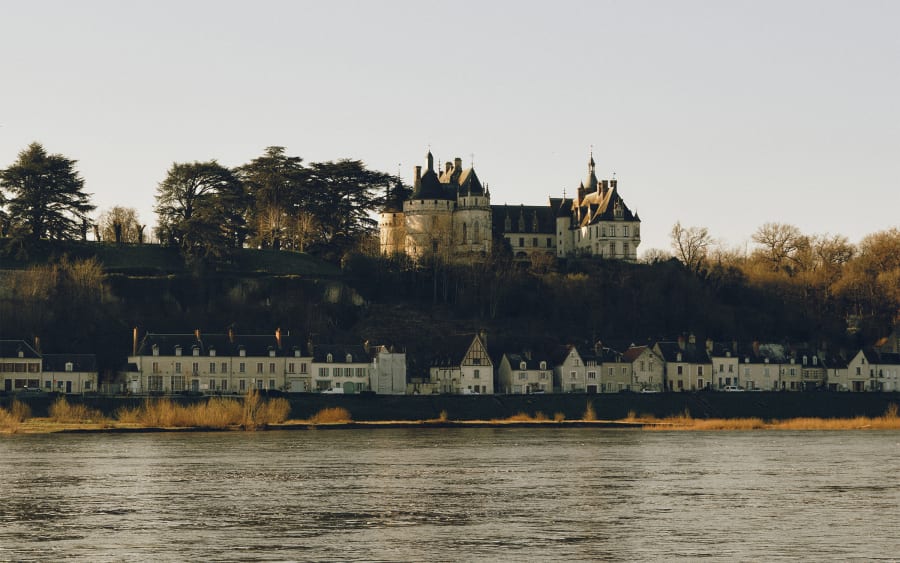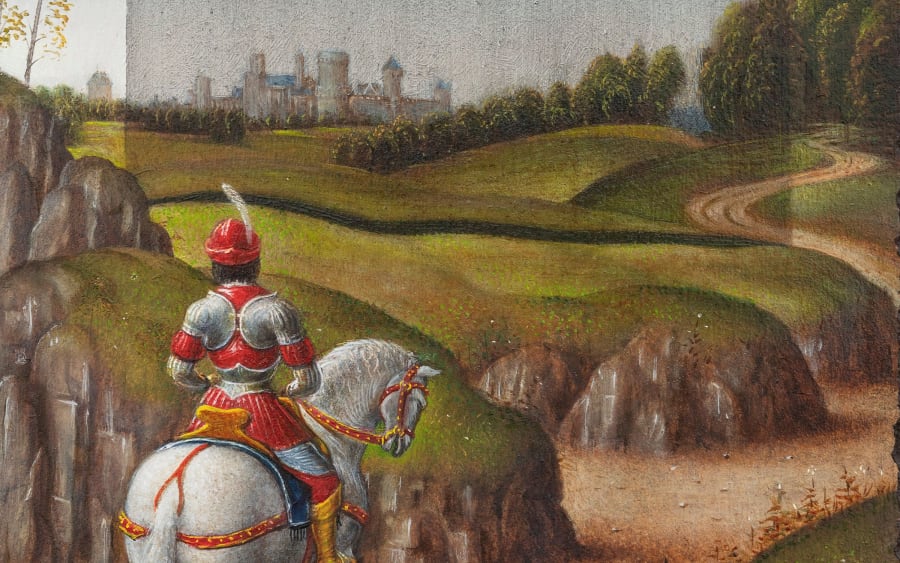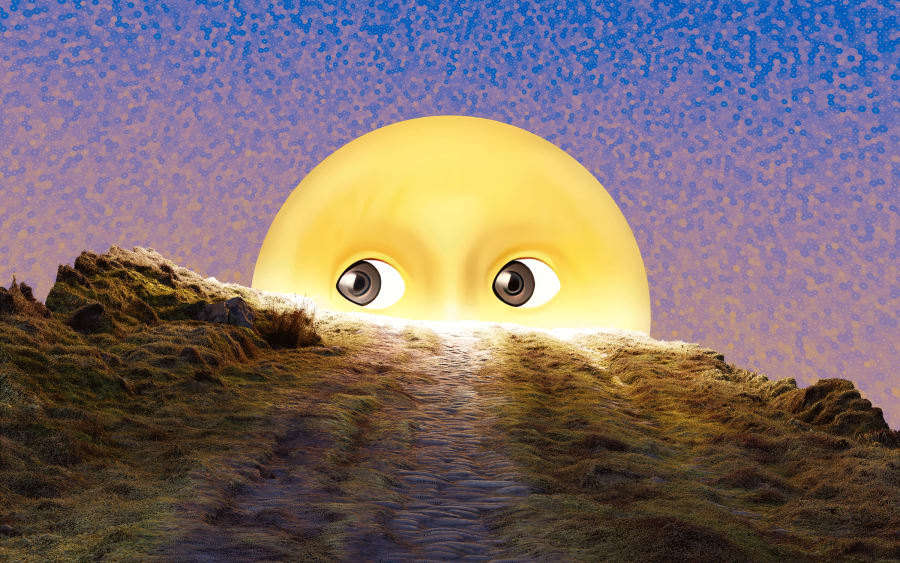Men in black clothing busy themselves around a purple crane preparing to hoist a metal sculpture. Rain is falling over Marseille. The ochre color of Fort Saint-Jean, constructed during the Middle Ages and fortified by Louis XIV, stands in stark contrast to the dark sky. It is atop the Tour du Roi René that Icarus, Us, Elle will be placed – a weather vane designed by Laure Prouvost as part of her new exhibition titled ‘Au fort, les âmes sont’ [In the fort, souls are], presented at the Musée des Civilisations de l’Europe et de la Méditerranée (Mucem) in Marseille, until September 28.
The French artist, who won the Turner Prize in 2013 and represented France at the 58th Venice Biennale in 2019, meets me in a café in the Old Port. On the wall there is a painted map of southern French cities and models of ships hang from the ceiling. Through the window, we can see a line of boats and Notre-Dame de la Garde illuminated on the hill as dusk falls. Laure Prouvost enters, her eyes disappearing into a huge smile. She points out of the window. At the other end of the quay, we can make out a flash of light on top of the tower.
Icarus, after the fall
Icarus, Us, Elle is a copper weather vane depicting a six-armed woman holding a sun or a glass eye, her legs pointing skyward. ‘She is both falling and floating,’ explains Prouvost. The inspiration is Pieter Bruegel the Elder’s painting The Fall of Icarus (c. 1558), in the collection of the Musées royaux des Beaux-Arts de Belgique in Brussels, in which Icarus is falling into the sea with only his legs, pointing up, visible.
‘I wanted to tell everything that happens in the water after the fall, that isn’t seen in the painting,’ explains the artist. She also wanted Icarus to be a female character to ‘reposition women as heroines’ while continuing the mythical metaphor. ‘Have we gone too close to the sun? Have we consumed too much? Can we relearn to live with the elements?’ she wonders.
In 2021, Prouvost created a similar sculpture for the Europalia festival in Brussels. Titled In your own time, tingalong, tingalong, Who’s been here since I’ve been gone?, the work was installed on top of a tower by Brussels-South station. The weather vane presented in Marseille was made by the same Belgian company, Dinanderie Clabots. But Marseille prompted new thoughts. ‘With Hélia Paukner [head of contemporary art at Mucem and curator of the exhibition], we wanted to present a work that speaks to the city on an elemental level. Icarus, Us, Elle rotates, shows us the wind, but it is also the connection point between all components of the exhibition.’
When asked what characterizes Marseille, Prouvost responds immediately: ‘The light! Here, the sun invigorates us.’ Then she mentions ‘the people…the characters…the great storms…the intense heat…the contrasts between stone and water.’ ‘Marseille is strong and intense. I love this intensity. I’m quite impressed by this city,’ she smiles.
Underwater videos
In the exhibition, four installations are positioned in different locations throughout Fort Saint-Jean – from which one can access the main Mucem building via a 130-meter-long walkway. In the room at Place du Dépôt, the audiovisual work Sous les flots, les âmes sont [Under the Waves, Souls Are] (2024) draws on underwater videos filmed near near Marseille on the Frioul islands and in the calanques. ‘In the water, we become dust, sand, algae, anemones. Organic elements develop. The half-human, half-animal characters metamorphose. We witness a kind of renewal,’ describes Prouvost. ‘But all this is expressed in a very abstract manner. There are no words. Yet, I never usually make videos without words. Here, we speak through plants, anemones, fans, divining rods.’
In the Saint-Jean chapel, objects selected from the Mucem collections are presented within a sound and light installation. Some have been duplicated in glass, in collaboration with Berengo Studio in Murano, Venice, and the Centre international de recherche sur le verre et les arts plastiques (Cirva). Here again, the aim is to evoke metamorphosis. ‘Found objects, gleaned, kept, cherished, collected trinkets...Do you hear their whispers? In the hopscotch of mirages, their spark-presences weave many stories. What does the one-eyed pot that smokes tell us, just emerged from the bride’s chamber?’ writes Paukner in the poetic text accompanying the installation. Prouvost’s work indeed establishes a dialogue with objects: ‘Some are salvaged items, without much value. But what has value and what doesn’t? What remains of our civilization? What have we created?’
Joy and imagination as resistance
At the Venice Biennale, in her project ‘Deep See Blue Surrounding You/Vois Ce Bleu Profond Tu Fondre’, Prouvost already addressed overconsumption and her desire to create more empathy with the living world. Since then, we haven’t really moved in that direction. But the artist insists on the necessity to ‘create places and moments of joy and imagination as acts of resistance. Even without being artists, we can all employ our imagination to invent new ways of thinking, being, or reacting,’ she says.
Finally, in the casemate of Fort Saint-Jean is the installation Into All That Is Here (2015), which recounts the quest of a grandfather who wants to dig ever deeper into the earth. ‘What’s interesting about exhibiting at Fort Saint-Jean is that it’s completely open to the public. There will be people who come for the garden and see a work by chance. Icarus, Us, Elle can be contemplated from the city. There is no separation between artistic moments and non-artistic moments. It somewhat breaks down boundaries,’ emphasizes Prouvost. At the end of the interview, she mentions her love of swimming with a mask and snorkel, and her desire to go walking in the calanques; I ask if she would like to return to create in Marseille: ‘Yes, but my home is very small, I won’t make a weather vane,’ she responds, laughing.
Laure Prouvost is represented by carlier gebauer (Berlin, Madrid); Lisson Gallery (London, Los Angeles, New York, Shanghai); Galerie Nathalie Obadia (Paris, Brussels).
‘Au fort, les âmes sont’
Mucem, Fort Saint-Jean – Fort Saint-Jean, Marseille
Until September 28, 2025
It will also be possible to discover Laure Prouvost’s work at the chapel of the Centre de la Vieille Charité where, supported by the city’s museums, she presents the new project Mère We Sea until January 11, 2026. The Musée d’art contemporain [mac] presents the video installation They Parlaient Idéale (2019), from May 17 to January 11, 2026.
Leïla Beratto is a journalist and filmmaker. She worked as a correspondent in Algeria for French-language media from 2012 to 2020. She is also co-founder of the online media outlet 15-38 Méditerranée.
English translation: Art Basel.
Published on April 3, 2025.
Caption for header image: Laure Prouvost, Sous Les Flots Les Âmes Sont (still), 2024. Production Mucem 2024-2025. Courtesy of the artist, Galerie Nathalie Obadia, Carlier Gebauer, and Lisson Gallery. © Adagp, Paris, 2025


